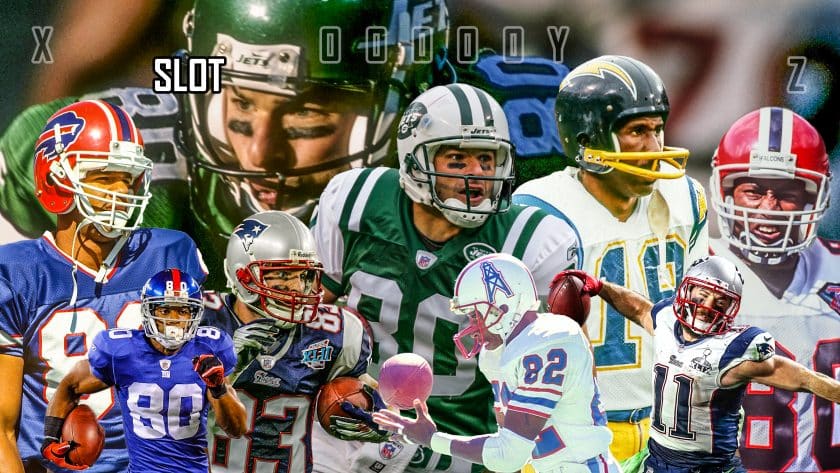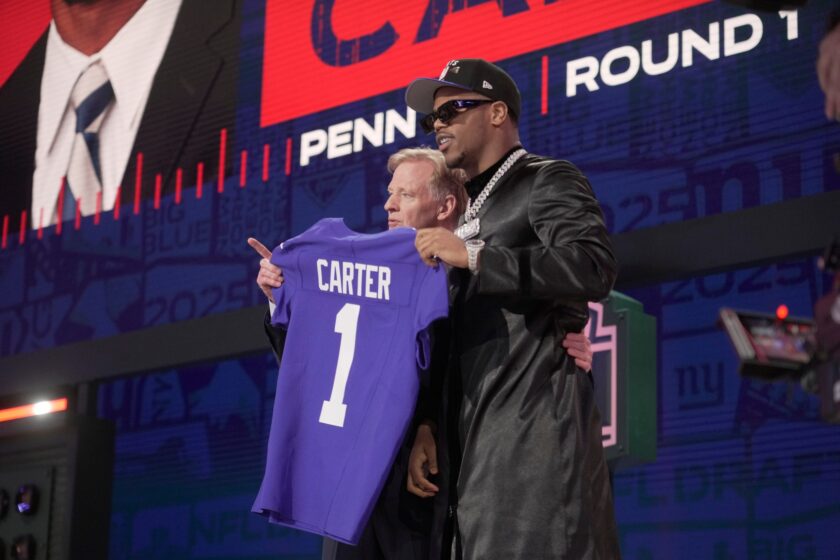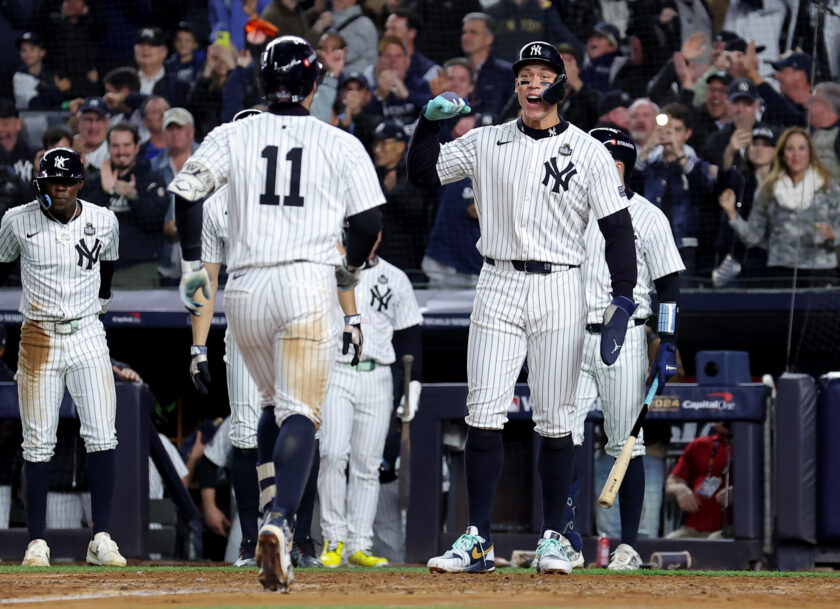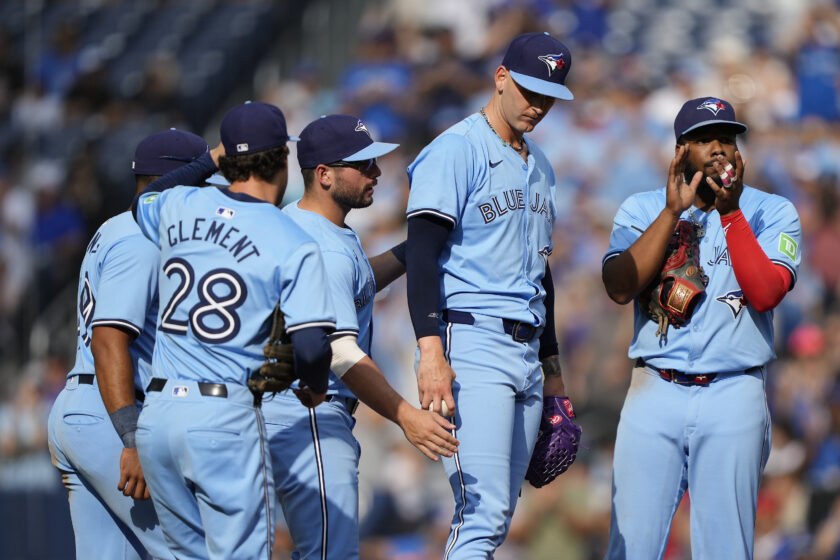New York Jets’ Wayne Chrebet & friends: Greatest slot WRs in NFL history

New York Jets legend Wayne Chrebet is one of the many great slot receivers to venture through the middle of nasty NFL defenses.
[sc name=”Robby Sabo Banner” ]Imagine.
It’s 3rd-and-7. You represent the slot wideout on the right side of the formation. X to the right, the Z and the tight end (Y) on the other side. Defensively, it’s a nickel. The nickelback is in a firm press, straight up technique with his hands ready to jab.
Your quarterback already knows presnap. You know the quarterback knows he’s going to you. Your job is to beat the man coverage and get open on the slant.
The center snaps the ball. You take a left step, drive hard to the right just before the release to the left in conjunction with an underneath rip to beat the press.
You did it. You’re open. All that’s needed now is to catch the ball while it’s led into the belly of the beast, the second level of a nasty NFL defense showcasing two inside linebackers and a possible strong safety (hello Steve Atwater) sniffing around the box and/or in a robber.
What choice do you have?
Catch the ball while looking to pick up a little YAC or catch while finding yourself as a part of the turf thanks to a 250-pound specimen smacking you in the earhole. These guys had a choice yet took on a role that sacrificed personal well-being in exchange for team success.
This is (was, prior to the new rules) the Sunday reality of slot receivers in the National Football League.
Early on, the slot receiver was as real as Sidd Finch. The pre-Super Bowl era featured heavy rushing attacks and “ends” as opposed to wide receivers. The T-formation or single-wing was a popular look. Then, shortly as the modern era kicked off, the slot formation was introduced.

The man who really pushed the slot-split back look was Oakland Raiders head coach Al Davis.
A disciple of Sid Gillman, David wasn’t the first to use the slot; he was simply the first to force the issue on a routine basis. The king of stretching the field vertically with speed was relentless.
Then Air Coryell happened.
San Diego Chargers head coach Dan Coryell became the first notable sideline boss to make extensive use of the three wide receiver set. This, in effect, ushered in the first sprinkle of the true slot receiver and forced the defense to counter with zone-blitz schemes (Dick LeBeau) and the nickel defense.


Of course, Coryell didn’t make use of 11 personnel (3WR, 1TE, 1RB) as extensively as it’s used today (well over 50 percent of all downs), but he absolutely drove its presence leaguewide.
During early days, the slot receiver was reserved for the shorter, slower weapon who just wasn’t good enough for the outside role. This continued during the 1980s and even during the early ’90s save for Bill Walsh‘s concept that every receiver needed to know his slot roles and route trees.
Today, there is no separation. While there are plenty who fit the spot much nicer, it’s a starting spot in its own right.
In this particular space of the internet, we countdown the greatest slot receivers in NFL history. Remember, the list is based on slot play alone. Don’t find yourself confused if some of the game’s greats who played a little slot aren’t listed ahead of lesser players who thrived in the slot extensively.
[sc name=”Generic Title” text=”Notables” ]- Cris Carter (MIN, PHI)
- Larry Fitzgerald (ARI)
- Jerry Rice (SF, OAK, SEA)
- Randall Cobb (GB)
- Doug Baldwin (SEA)
- Jarvis Landry (CLE, MIA)
- Golden Tate (SEA, DET, PHI)
Cris Carter, Larry Fitzgerald, and the best to ever do it, Jerry Rice, in the notables section? Yeah, like I already mentioned, we’re talking slot. If this was a greatest wide receiver of all-time, it’d be much different.
Rice qualifies due to Bill Walsh’s West Coast mindset. Within his offense, every weapon needed to know every position. This even reached down to the back spot as Roger Craig, Ricky Watters, and Tom Rathman had to be on their heels at all times.
While Rice didn’t play a ton of slot, he was still extremely effective when put in the spot during the early days of the position. Overall, he was much more vertical than horizontal making him a nastier matchup along the sideline.
https://www.youtube.com/watch?v=f0OdVFKkuvY
Larry Fitzgerald didn’t start out as a slot guy, but over the last several seasons, it’s where he’s thrived. Randall Cobb, Golden Tate, Doug Baldwin, and especially Jarvis Landry are all representatives of modern-day slot assassins.
[sc name=”Generic Title” text=”10. Hines Ward” ]Hines Ward represents one of the most underrated wide receivers in NFL history. Despite his height and lack of top-flight speed, he could line up outside and in the slot. This is exactly the reason why he isn’t higher on the list; his versatility allowed him the freedom to roam presnap.
Snagging an even 1,000 receptions for 12,085 yards and 85 touchdowns, the man was simply a beast in the slot, especially during the Ken Whisenhunt days.
Oh yeah, and his blocking at the position is probably the best high-impact job we’ve ever seen. Rolling with crackbacks from the slot was an edge player’s worst nightmare when lining up against Hines Ward. Having the ability to block like that from the slot allows for a non-tipping hand (due to no towards to the line-of-scrimmage motion).

Notre Dame product Tim Brown loved playing the slot and for many years, he had the perfect coach to allow him to get it done.
In Jon Gruden’s offense, Brown frequently played inside. At 6-foot and 195 pounds, Brown’s stature perfectly suited the inside ways of a west coast system.
[sc name=”Generic Title” text=”8. Victor Cruz” ]Perhaps no slot receiver over the course of NFL history enjoyed such a short period of dominance than Victor Cruz.
Make no mistake about it, the man could do it all. The 2011 New York Jets understood this better than anybody. But when Kevin Gilbride—former disciple of the Run and Shoot—opened it up with an 11 personnel look, Cruz took to the slot and provided headaches for just about every defensive coordinator.
If not for only 70 career games, Cruz would be in the top three. Just understand his story—an undrafted guy who upended all the odds, a familiar underdog story that reverberates throughout slot wideout NFL history.
Cruz and Eli Manning were as dangerous a duo as we’ve ever seen.

Speaking of the Run and Shoot, here comes Andre Rison.
When Rison arrived in Atlanta in 1990, it was over. Under Jerry Glanville’s watchful eye, Rison collected 1,208 yards and 10 scores on 82 receptions.
For those unaware, the Run and Shoot showcased a four wideout look with a single-back look. Its principles were heavy in a vertical passing attack grounded in quarterback-to-receiver trust. The route trees were extensive, meaning the specific defensive looks would dictate routes.
Rison was the Falcons top slot man for much of his five seasons in Atlanta. He then captured a ring with Brett Favre in 1996 while playing the slot to starters Antonio Freeman and Robert Brooks.
[sc name=”Generic Title” text=”6. Andre Reed” ]From the Run and Shoot to the K-Gun, we now touch on Andre Reed.
The Kutztown product may have showcased a few outbursts at times, but when he slid into the slot for Jim Kelly, madness ensued.
[sc name=”NFL Center” ]Reed amassed 13,198 yards and 87 touchdowns on 951 grabs over a 16-year career. The only thing keeping him higher on the list was his dangerous presence as an outside guy as well. Don Beebe shared the slot workload with Reed for much of the K-Gun era.
[sc name=”Generic Title” text=”5. Julian Edelman” ]Now we’re getting somewhere slot heavy. For everything historical Tom Brady‘s done, his breeding of slot greats shines through.
Since Bill Belichick turned the salary-cap strategy from defensive to offensive after the 2006 AFC Championship Game (loss to Peyton Manning‘s Indianapolis Colts), the Pats have deployed a short, very-well timed passing attack.
It’s created slot monsters, Julian Edelman included.
Look no further than this past week’s AFC title game against the Kansas City Chiefs. When Brady needed Edelman over the middle, he was there.
Edelman also represents that true underdog slot story that’s seemingly universal. As a 4-foot-10 freshman in high school, nobody believed he could take it to the highest level.

When Atlanta was enjoying Run and Shoot times with Chris Miller in the early 1990s, the Houston Oilers were already swimming in it. Not surprisingly, that’s exactly where Jerry Glanville came from.
Under Kevin Gilbride’s direction, Ernest Givins, standing just 5-foot-9 and weighing only 178 pounds, was as electric as they come out of the slot.
He never put up massive single-season numbers, mainly due to the wealth shared with four wideouts, but Givins exemplified everything the slot was about during his era.
[sc name=”Generic Title” text=”3. Charlie Joiner” ]Charlie Joiner is the original slot target.
Thanks to Air Coryell, the 5-foot-11, 188-pound Joiner turned into Dan Fouts‘s most consistent and reliable slot weapon.
The three-time Pro-Bowl selection may have appeared to play second or even third fiddle to outside studs like John Jefferson and Wes Chandler, and tight end Kellen Winslow, but he paved the way for every other name on this very list.
[sc name=”Generic Title” text=”2. Wes Welker” ]Wes Welker is considered by many as the greatest slot receiver of all-time. Though I think nothing ill of that notion, the man did have Tom Brady and Peyton Manning at his disposal.
The moment he arrived in Foxborough with Randy Moss was the very instance the entire NFL knew things had changed in the northeast. With Moss’s vertical game and Welkers no-fear underneath out of the slot, Brady broke the single-season touchdown mark during the Pats perfect 16-0 regular season.
He was incredibly smart. Welker always knew which route to run and exactly where to fit in along the second level. He cemented the commencement of the golden age of slot receivers.

What’s the golden age of slot receivers without New York Jets legend Wayne Chrebet actually kicking it off?
If Charlie Joiner was the first and Wes Welker the cementer, Chrebet was the guy who made everybody take notice of the less-than-athletic-enough, too-small-to-play underdog slot man.
Am I biased? Perhaps. He still represents an entire generation of kids who aspire to make it big while not possessing the tools needed to receive that prestigious invite to the NFL Combine.
Also understand this: the slot receiver’s top chore is third down. Chrebet tallied 379 third-to-first down receptions within his 580 career receptions. The man was money when it counted most. Just look at the Monday Night Miracle and the Green Lantern Game (the Keyshawn Johnson revenge contest) as evidence.
Welker can easily be No. 1. Statistically, he should be. In the end, however, it’s the respect that’s overwhelming:
Across the middle till the day we die. @Edelman11 @waynechrebet #theGodfather pic.twitter.com/tqmstkHq6v
— Danny Amendola (@DannyAmendola) May 1, 2016
The lone solid move Rich Kotite pulled off in New Jersey was pointing to No. 3 (during camp and preseason) and saying aloud, “Yes, this undrafted Hofstra kid has what it takes to play professional football.”
The North Jersey kid looked so out of place that Jets security infamously wouldn’t allow him access to the building on day one. He was literally stopped and detained, not provided entrance to the team’s facility by a guard who thought he was too small to account as a real NFL player. A few phone calls were needed to grant him access.
No receiver throughout the history of the game inspired the way the Garfield native did. The fashion in which the 5-foot-10, 188-pound kid ventured the middle of the field was beyond fearless. Forget fearless, it was absolutely reckless.
In the end, he paid the price. Rumors of his struggling health hit media outlets from time-to-time, forcing MetLife Stadium to grow with even more No. 80 jerseys on Sundays.
The outpouring of love from within the organization and respect from the outside is simply amazing for a player who only picked up 7,365 yards and 41 touchdowns on 580 career receptions.
Break it down any way you’d like between the top two, Chrebet and Welker. Just understand it was Wayne Crebet who turned this slot business into a legitimate idea during an era that viciously punished anybody who dared to cross the belly of the beast.
https://www.youtube.com/watch?v=ZNZ3lx1AgtM

Robby Sabo is a co-founder, CEO and credentialed New York Jets content creator for Jets X-Factor - Jet X, which includes Sabo's Sessions (in-depth film breakdowns) and Sabo with the Jets. Host: Underdog Jets Podcast with Wayne Chrebet and Sabo Radio. Member: Pro Football Writers of America. Coach: Port Jervis (NY) High School. Washed up strong safety and 400M runner. SEO: XL Media. Founder: Elite Sports NY - ESNY (Sold in 2020). SEO: XL Media.
Email: robby.sabo[at]jetsxfactor.com






